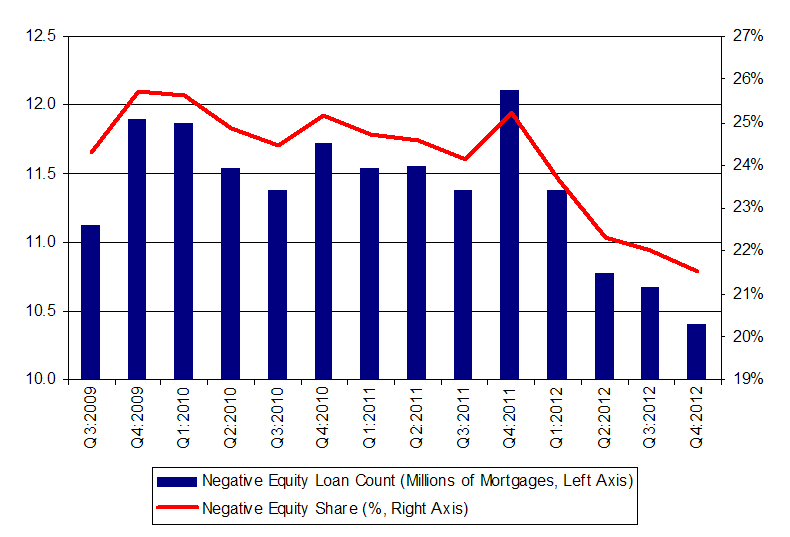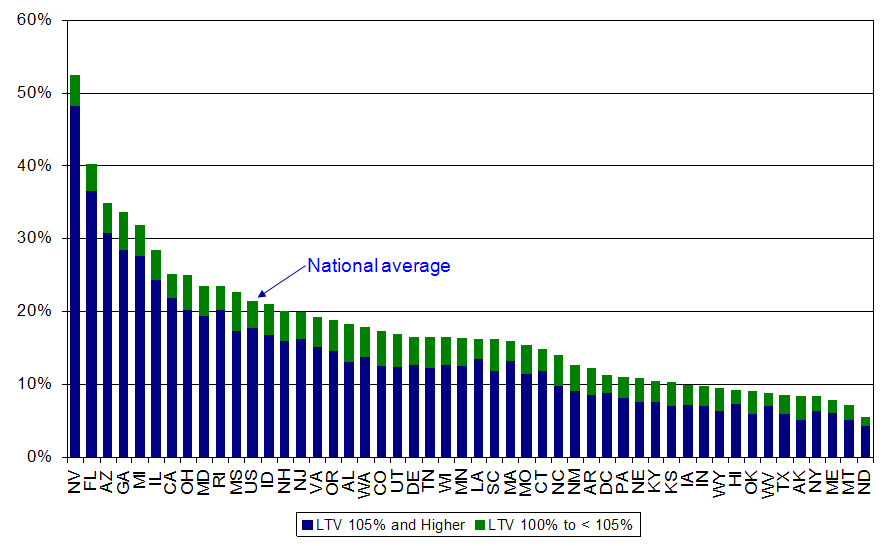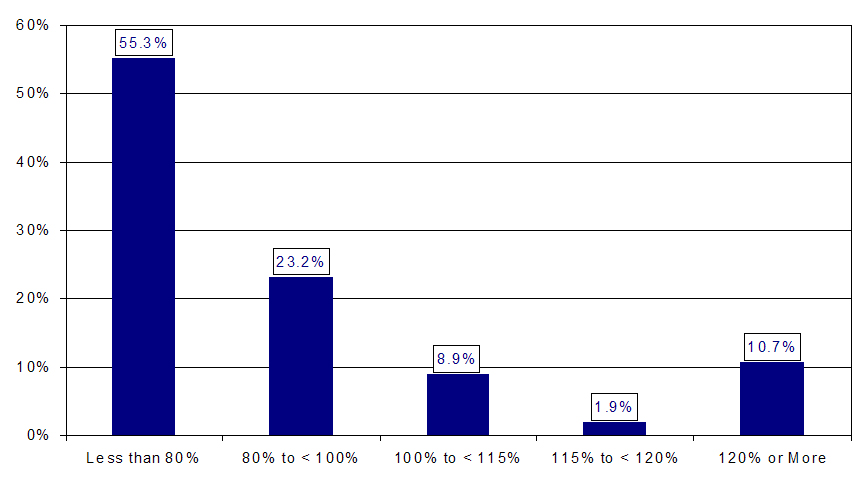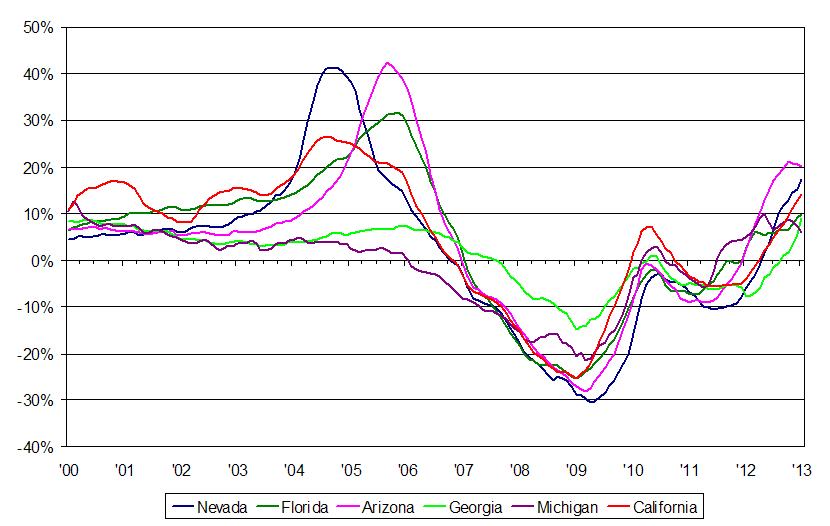Down But Not Out: Many Underwater Borrowers Will Likely Regain Buoyancy This Year

The broadening housing recovery in 2012 has brought with it firming home prices around the country and thus the potential mending of many underwater mortgages. The first annual rise in home prices on a national basis in six years has contributed to a positive feedback loop for the housing market by helping many underwater homeowners—those whose mortgages exceed the value of their homes—regain their positive equity positions. This improving trend should help spur mobility and housing turnover, and transition the housing market toward “normal” activity. The broader economy also should benefit. The latest Federal Reserve flow of funds showed that household net worth rose strongly in the final quarter of 2012, reaching the highest level in five years, in part because of rising home equity, which helps boost confidence and support consumers amid ongoing fiscal drags.
Main measures of home prices showed continued robust gains so far this year, thanks to an improving labor market, low mortgage rates, and very lean inventory. Investor demand has commanded a strong presence in many markets, and organic demand, as gauged by purchase mortgage applications, has not picked up substantially. In fact, the principal driver of robust home price gains over the past year has been tight supply, as seen by various indicators, including listings of existing homes and the number of new homes available for sale that have trended down to depressed levels.
In some markets, such as Phoenix and Las Vegas, institutional investors contributed to a sharp decline in REO inventories and supply shortages. Furthermore, many homeowners have been unable or unwilling to list their properties for sale because they are underwater on their mortgages or they prefer to wait for additional home price gains.
Rising home prices should help some homeowners who have involuntarily remained on the sidelines to put their homes on the market, as more than 1.7 million properties returned to positive equity by the end of 2012.i Figure 1 shows that the number of underwater residential properties peaked in the fourth quarter of 2011 at 12.1 million and steadily declined in each quarter of 2012, with 10.4 million properties remaining in negative equity by year end. The share of properties with negative equity, which peaked during the fourth quarter of 2009, also trended down to 21.5 percent in the final quarter of 2012.
Figure 1: Negative Equity Residential Properties Have Declined Sizably Over the Past Year

Source: CoreLogic
Underwater properties remain concentrated in a few states, with those in the worst five states accounting for nearly a third of total underwater properties (see Figure 2). At the end of 2012, about 3.7 percent of properties nationwide were in a slightly negative position, defined here as those with loan-to-value (LTV) ratios of 100 to less than 105 percent. These properties may switch to positive equity positions this year assuming home prices continue their upward trend. The share of properties with a slightly negative equity position varied across the country, ranging from 1.3 percent in North Dakota to 5.4 percent in Georgia.
Figure 2: Worst Ten States Account for 32.7 Percent of Nation’s Negative Equity Properties
Share of Residential Properties with Negative Equity (LTV of 100% or higher) by State

Source: CoreLogic
Most housing analysts expect home prices to trend up this year. For example, in the March Zillow survey of home price expectations, which tallies responses from more than 100 companies (including Fannie Mae), the consensus median appreciation in 2013 was 4.8 percent, with only two respondents out of 117 indicating a decline.
To gauge the extent of how home price appreciation can lift some underwater properties into positive equity positions over time, we examine the share of underwater properties by LTV buckets (see Figure 3). Properties with the most severe negative equity, defined here as those with an LTV of 120 percent or higher, comprised slightly more than 10 percent of total residential properties with mortgages. Even with reasonably strong home price gains over the next few years, these properties will likely remain in negative equity positions, unless the borrowers default or prepay. Those underwater properties with an LTV between 100 and less than 120 percent could potentially move into positive equity positions with continued home price appreciation amid ongoing amortization. Applying the Zillow survey’s consensus home price appreciation expectation, which shows a cumulative gain of 17.5 percent between 2013 and 2016, and assuming continued amortization, most of the underwater properties at the end of 2012, except the most severe, would likely regain their positive equity positions by 2016—the same time that the forecast of our Economic and Strategic Research (ESR) Group indicates that housing-related activity, including home building and residential construction employment, will return to “normal.”ii
Figure 3: A Cumulative Home Price Gain of 20 Percent Over the Next Several Years Should Help Most Mortgages Regain Positive Equity, Except the Most Severely Underwater
Share of Total Residential Properties with Mortgages by LTV (%)

Source: CoreLogic
The speed of the transition of these underwater loans to positive equity positions is expected to vary regionally, depending on the severity of their underwater conditions (i.e., their LTV) and the pace of home price gains in each area. While Nevada and Arizona are among the states with the highest share of negative equity properties, these states witnessed very robust home price gains over the past year (see Figure 4). Michigan’s negative equity share was the lowest among the five worst states, but its home price appreciation also has been the most modest. Strong home price appreciation bodes well for California, which was consistently among the five worst underwater states until the second quarter of 2011. Since then, California has moved out of the worst five states, as its home prices troughed in the first quarter of 2011—much sooner than trends have demonstrated in other severely underwater states and compared to the national average, which witnessed a trough in home prices in 2012.
Figure 4: The Pace of Home Price Gains is Key to States’ Transition to Positive Equity
CoreLogic House Price Index by State (Year-over-Year % Change)

Source: CoreLogic
Orawin Velz
Director, Economic and Strategic Research
The author thanks Brian Hughes-Cromwick for assistance with CoreLogic data.
April 24, 2013
Opinions, analyses, estimates, forecasts and other views of Fannie Mae's Economic & Strategic Research (ESR) group included in this commentary should not be construed as indicating Fannie Mae's business prospects or expected results, are based on a number of assumptions, and are subject to change without notice. How this information affects Fannie Mae will depend on many factors. Although the ESR group bases its opinions, analyses, estimates, forecasts and other views on information it considers reliable, it does not guarantee that the information provided in these materials is accurate, current or suitable for any particular purpose. Changes in the assumptions or the information underlying these views could produce materially different results. The analyses, opinions, estimates, forecasts and other views published by the ESR group represent the views of that group as of the date indicated and do not necessarily represent the views of Fannie Mae or its management.
The views expressed in these articles reflect the personal views of the authors, and do not necessarily reflect the views or policies of any other person, including Fannie Mae or its Conservator. Any figures or estimates included in an article are solely the responsibility of the author.
i CoreLogic, Q4 2012 Equity Report, March 19, 2013.
ii (See Brian Hughes-Cromwick, FM Commentary: Transitioning to "normal": What Does a Healthy Housing Market Look Like and How Far off Is It?, March 14, 2013.)
